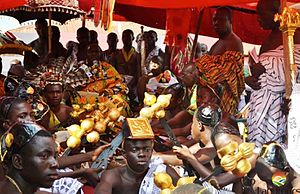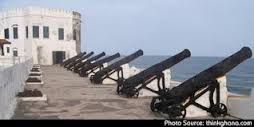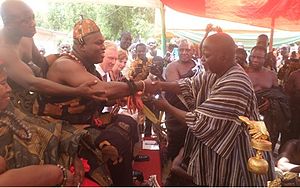Akwamu
| Total population | |
|---|---|
| (Unknown) | |
| Regions with significant populations | |
| Accra, Brong Ahafo Region, Eastern Region, Ashanti Region, Volta Region of Ghana, Togo, Benin | |
| Languages | |
| Twi | |
| Religion | |
| Christianity, African Traditional Religion | |
| Related ethnic groups | |
| Akan |
Akwamu (also called Akuambo) was a state set up by Akan people (in present-day Ghana) that flourished in the 17th and 18th centuries. The name was also applied to its people.[1] Originally immigrating from Bono state, the Akan founders settled in Twifo-Heman.[2] The Akwamu led an expansionist empire in the 17th and 18th centuries. At the peak of their empire, the Akan created an influential state and culture that has contributed to at least three countries in West Africa.
Contents
History
Akwamus are the Abrade (Aduana) Clan of Akan tribe. According to the oral traditions, they originated from ancient Ghana. They migrated from the north, they went through Egypt and settled in Nubia (Sudan). Around 500AD (5th century), due to the pressure exerted on Nubia by Axumite kingdom of Ethiopia, Nubia was shattered, and they moved to the west and established small trading kingdoms which later grew and became wealthy and powerful state. By 750AD, the kingdom had become an Empire called Ghana. The Empire lasted from 750AD to 1200AD and collapsed as a result of the introduction of Islam in the Western Sudan, and the zeal of the Muslims to impose their religion, their ancestors left for Kong (i.e. present day Ivory Coast). From Kong they moved to Wam. From Wam they moved to Bono Manso, then to Dormaa (these are both on present day Brong-Ahafo region). The movement from Kong was necessitated by the desire of the people to find suitable Savannah conditions since they were not used to Forest life. Around the 14th century, they moved from Dormaa south and went eastwards to Twifo-Hemang, North West Cape Coast. The move was commercially motivated and settled at the Twifo-Heman forest in the later part of the 16th century. Akwamus are Akans, they belonged to the Aduana family who are blood brothers of Asumennya, Dormaa and Kumawu. According to oral tradition, a succession dispute resulted in Otomfuo (brass-smith) Asare deserted the family to form a new state or city called Asaremankesee (Asare's big state). The modern city of Asaremankese was originally founded and occupied by the Akwamus.
Akwamu expansion started between 1629–1710. They migrated into the Akuapem area, including Kyerepon and Larteh, Denkyera, Ga-Adangbe; and the Ladoku states of Agona, Winneba, Afram plains, Southern Togoland and finally Ouidah in present-day Benin. The powerful king Nana Ansa Sasraku I annexed the Guan and took over the traditional areas of the Kyerepon. He ruled over them until Asonaba Nana Ofori Kuma and his followers, after a succession dispute in an effort to form their own State, engaged them in a fierce war. The Akwamu were driven away from the mountains.
These Asona family members and their followers were given a piece of land by the Guan and Kyerepon, the original settlers, to form the Akuapem state. But, most of the present Akuapem still have their roots at Akwamufie, especially those bearing the names Addo and Akoto, or who are from the Aduana family.
Nana Ansa Sasraku also played an important role in the life of the King Osei Tutu of Asante by protecting him from the Denkyira. Osei Tutu whose real name is Osei Kofi Tutu foundered Asante Empire. Osei Tutu's father name is Owusu Panin from Akwamu and his mother is named Manu Kotosii who also was from Kwaaman. She was the sister of Oti Akenten and Obiri Yeboa the late kings of Kwaaman. When Manu was unable to have children, her brother Obiri Yeboa sent her to a shrine priest called Otutu in Akwamu for help. Later she conceived and gave birth to a baby boy (Osei Kofi) and named him after the shrine called Tutu; by then Kwaaman was under the Denkyiria so when Osei was teenager, he was sent to serve at the court of Boa Amponsem, the then king of Denkyiria. Later, Osei got himself into trouble by impregnating the king's sister called Akobena Bensua and ran to his father at Akwamu for protection. When Osei got to Akwamu, Otumfuo Ansa Sasraku received him and treated him very well; and also protected him from the Denkyirias. Later, Osei Tutu met Kwame Frimpong Anokey (a.k.a. Okomfo Anokey) and he became his friend. Shortly after that Osei's uncle, Obiri Yeboa, the then king of Kwaaman died in their war against Domaa; and as a result, Osei had to become the next king but he was afraid of the Denkyirias to go back to Kwaaman so Otumfuo Ansa Sasraku detached 300 Akwamu soldiers to guide him to Kwaaman. When the soldiers got to Kwaman, they settled among them and later became citizens of Asafo. The soldiers then restructured the Asante army as the replica of the well-organised Akwamu army and with the help of the Akwamus, they embacked on series of campaigns which led to the defeat of the Denkyiras; the Asante Stool then became the wife of the Akwamu Stool but when the Akwamu was facing the combined force of Akyem (Abuakwa, Kotoku and Bosome), Ga, Kyerepong, and the Dutch, the Asantes pretended they knew nothing about it and did not help the Akwamus which led to their defeat in 1734. Although Akwamu lost the western part of the Empire, it was quick to reestablished itself and controlled the eastern part of the Empire that was from the east bank of the Volta river to Dahomey. Consequently, when the Asantes fought the British, the Akwamus tried to help but withdrew their help and the Asantes was defeated. Despite all these Akwamus and Asantes are still strong allies.
Nana Osei Tutu was assisted in execution cases by the Anumfuo (later Adumfuo) who accompanied him from Akwamu. In the 21st century, numerous Asante trace their ancestry to Akwamu especially; these included people from Asafo and Adum, as well as sections of the people from Bantama and Barekese.
After the death of Nana Ansa Sasraku, he was succeeded by two kings collectively, Nana Addo Panin and Nana Basua. It was during this time that the Akwamu took over the possession of the trading Danish Castle at Christianborg at Osu, in present-day Accra.
Because of the cordial relationship between Akwamu and Asante, during the 19th-century expansion of Asante, it never annexed the Akwamu. During the Golden Anniversary of Nana Kwafo Akoto II, Nana Opoku Ware I crossed the Pra River to spend two days at Akwamufie.
At the peak of their power, the Akwamu state encompassed much of the eastern part of the present-day Gold Coast. It is traditionally thought that between 1677 and 1681, the Akwamu state conquered the states of Ladoku, Agona and Whydah, as well as the Ewe people of the Ho region.[3] The Akwamu also conquered the Ga people and occupied the old Ga Kingdom.[3]
In 1693, the Asimani of Akwamu led a raid and seized Osu Castle (currently the seat of the Ghanaian government), from the Danish colonists.[4] The Akwamu thus controlled many of the trade routes from the interior to the coast in the eastern half of what is now Ghana and created a capital at Nyanoase.[5]
In the 1720s a civil war in the Akwamu state caused great hardship. The victors sold most of the King's allies as slaves and they were transported to the Caribbean island of St. John. In 1733 they fomented a slave revolt on the island.[6]
In 1734 the Akwamu were defeated by the Akyem, and their empire came to an end. The Akwamu were pushed to Akwamufie, the location of their current capital.
List of rulers of the state of Akwamu (formerly Twifo-Heman)
| Akwamu rulers | Period of reign | ||
|---|---|---|---|
| Otumfuo Agyen Kokobo | 1505-1520 | ||
| Otumfuo Ofosu Kwabi | 1520-1535 | ||
| Otumfuo Oduro | 1535-1550 | ||
| Otumfuo Addow | 1550-1565 | ||
| Otumfuo Akoto I | 1565-1580 | ||
| Otumfuo Asare | 1580-1595 | ||
| Otumfuo Akotia | 1595-1610 | ||
| Otumfuo Obuoko Dako | 1610-1625 | ||
| Ohemmaa Afrakoma | 1625-1640 | ||
| Otumfuo Ansa Sasraku I | 1640-1674 | ||
| Otumfuo Ansa Sasraku II | 1674-1689 | ||
| Otumfuo Ansa Sasraku III | 1689-1699 | ||
| Otumfuo Ansa Sasraku IV (Addo) | 1699-1702 | ||
| Otumfuo Akonno Panyin | 1702-1725 | ||
| Otumfuo Ansa Kwao | 1725-1730 | ||
| Otumfuo Akonno Kuma (Regent) | 1730-1744 | ||
| Otumfuo Opoku Kuma | 1744-1747 | ||
| Otumfuo Darko Yaw Panyin | 1747-1781 | ||
| Otumfuo Akoto Panyin | 1781-1835 | ||
| Otumfuo Dako Yaw Kuma | 1835-1866 | ||
| Otumfuo Kwafo Akoto I (Okorforboo) | 1866-1882 | ||
| Otumfuo Akoto Ababio (Kwame Kenseng) | 1882-1887 | ||
| Otumfuo Akoto Ababio II (Okra Akoto) | 1887-1909 | ||
| Otumfuo Akoto Kwadwo (Mensa Wood) | 1909-1910 | ||
| Otumfuo Akoto Ababio III (Emmanuel Asare) | 1910-1917 | ||
| Otumfuo Ansa Sasraku V (Kwabena Dapaa) | 1917-1921 | ||
| Otumfuo Akoto Ababio IV (Emmanuel Asare) | 1921-1937 | ||
| Odeneho Kwafo Akoto II (Kwame Ofei) | 1937-1992 |
Territory comprised part of present-day southern Ghana
| Tenure | Incumbent | Notes |
|---|---|---|
| Akwamuhenes (Rulers) | ||
| Twifo-Heman | ||
| c.1480 to c.1500 | Agyen Kokobo, Akwamuhene | Founder of Twifo-Heman |
| c.1500 to c.1520 | Ofusu Kwabi, Akwamuhene | |
| c.1520 to c.1540 | Oduro, Akwamuhene | |
| c.1540 to c.1560 | Ado, Akwamuhene | |
| Akwamu | ||
| c.1560 to c.1575 | Otumfo Asare, Akwamuhene | Founder of the Akwamu State, with capital at Asaremankesse |
| c.1575 to c.1585 | Akotia, Akwamuhene | Relocated capital at Ayandawaase |
| c.1585 to c.1600 | Ansa Saseraku, Akwamuhene (Ansa Saseraku I) |
|
| c.1600 to c.1620 | Ansa Saseraku, Akwamuhene (Ansa Saseraku II) |
|
| c.1620 to c.1640 | Ansa Saseraku, Akwamuhene (Ansa Saseraku III) |
|
| c.1640 to c.1660 | Abuako Dako, Akwamuhene | |
| c.1660 to c.1680 | Afera Kuma, Akwamuhene | |
| c.1680 to 1702 | Manukure, Akwamuhene | |
| 1702 to 1726 | Akwano Panyini, Akwamuhene | |
| 1726 to 1734 | Dako Booman, Akwamuhene | |
| 1734 | Conquest by the Akyem peoples | |
References
B.Osei-Akoto from Ghanaweb
- ↑ Lua error in package.lua at line 80: module 'strict' not found.
- ↑ Lua error in package.lua at line 80: module 'strict' not found.
- ↑ 3.0 3.1 Muḥammad Zuhdī Yakan, Almanac of African Peoples & Nations, p.161
- ↑ Lua error in package.lua at line 80: module 'strict' not found.
- ↑ Kwamina B. Dickson, A Historical Geography of Ghana, p.23
- ↑ Hartman, Saidiya. Lose Your Mother: A Journey Along the Atlantic Slave Route. (New York: Farrar, Straus and Giroux, 2007) pp. 91-93
Further reading
- Lua error in package.lua at line 80: module 'strict' not found.
- Lua error in package.lua at line 80: module 'strict' not found.





